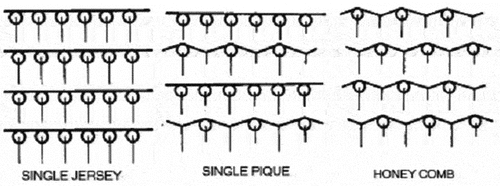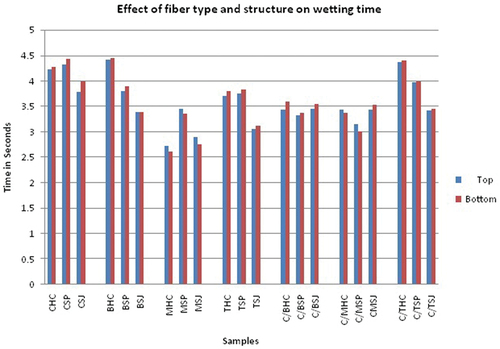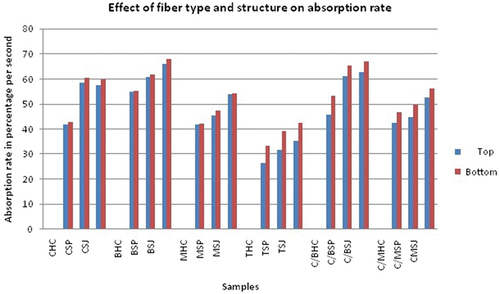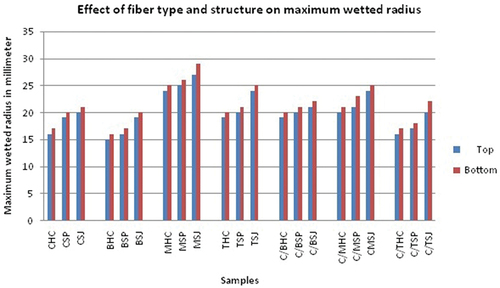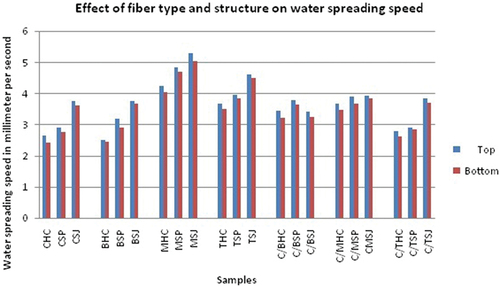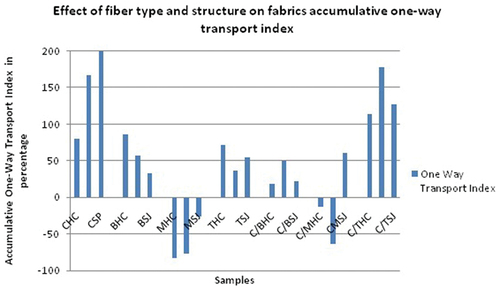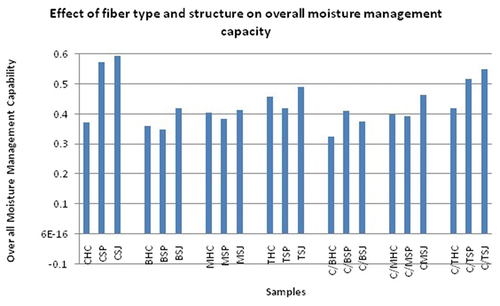ABSTRACT
The ability to transport and evaporate moisture quickly and effectively is a very essential and expected property of a fabric chosen for the clothing purposes. The present study analyzed the moisture management properties of four different natural and manmade cellulosic fibers, its blends and by varying three different knitted structures using moisture management tester. The result reveals that the modal fiber wicks and spreads quickly and it requires an average 50% lesser time than other fiber samples. Among the three structures, single jersey fabrics showed excellent behavior of transportation of moisture through its surface. Single jersey modal fabric was rated as superior moisture management fabric, which can be recommended for the applications such as sportswear, where high moisture management properties with greater comfort are demanded.
摘要
快速有效地运输和蒸发水分的能力是为服装目的选择的织物的一个非常重要和预期的性能. 本研究使用水分管理测试仪,通过改变三种不同的针织结构,分析了四种不同天然和人造纤维素纤维及其混纺物的水分管理性能. 结果表明,莫代尔纤维芯吸和扩散速度快,平均所需时间比其他纤维样品少50%. 在这三种结构中,单面针织物表现出优异的表面水分传输性能. 单面针织莫代尔面料被评为优异的防潮面料,可推荐用于运动服等要求高防潮性能和更舒适的应用场合.
Introduction
The capability of a fabric to regulate or transport moisture from one place to other is called moisture management of textile fabric. Moisture management properties of the clothing material are very essential as it plays a major role in transporting liquid moisture from the human skin to the outer environment to maintain high level of comfort to the wearer. This moisture management character is extremely demanded for the clothing such as intimate apparels, sportswear, active wear, etc., where the high amount of dissipated moisture vapors and liquid moisture (perspiration) needs to be transported from the skin to the outer environment for dry feel (Das et al. Citation2007). If the moisture is not transported, it creates sticky feel and increases the friction between and skin and the fabric which restricts the body movement and results in lesser performance of the wearer. The selection of fabrics for these applications has to be carried out with maximum cautiousness to provide comfort.
Different combinations of fibers, yarns and fabrics were developed and involved in designing sports and active wear. Many researchers have studied the influence of variety of materials, yarns and fabrics on comfort properties. The liquid moisture management property of fabrics is a complex propertiy which includes the absorbent ability, absorption speed and evaporation of the fabric (Sampath and Senthilkumar Citation2009).
The moisture absorbent ability, absorption speed and evaporation of the fabric depend on many numerous factors such as fiber source, extraction method, fiber type, etc. (Khalid et al. Citation2021a). Nowadays, synthetic fibers are vastly utilized for multiple purposes, but the application of natural and manmade cellulosic fibers has its own merits and they are environmental friendly and easily decomposable (Khalid. et. al Citation2021b). This would be promising alternative for non-degradable fibers (Khalid et al. Citation2020; Khalid et al. Citation2021c). Only limited research was there to ascertain the suitability of natural and manmade cellulosic fabrics for moisture management properties. Hence further research have to be carried out to maximize the application to find the suitability for all the end uses (Khalid et al. Citation2021d; Al Rashid et al. Citation2020).
Kandhavadivu (Citation2011) reported that the type of fiber and fabric structure effects the properties of final fabric produced. Blending of various fibers in different proportion is carried out to improve the qualities of performance and aesthetic values of the fabrics. Chidambaram, Govind, and Venkataraman (Citation2011) analyzed the effect of linear density, blend ratio and fabric type on moisture management behavior of bamboo knitted fabric and stated that the fabric thickness influence the liquid transport and bamboo content affects the absorption rate and drying property. Similar observation weas recorded by Ozdil et al. (Citation2007), Bivainyte and Mikučioniene (Citation2011). Ozturk et al. (Citation2011) analyzed the effect of count of the yarn on wicking behavior and recorded that the wicking is is directly proportional to yarn count. Das et al. (Citation2008) investigated the wicking property of yarn in the vertical wicking method and in-plane wicking method and found that increase in yarn fineness is reduces the in-plane wicking. Priyalatha et al. (Citation2017) studied the wicking of knitted fabric under deformations and stated that the multidirectional deformation increases the wicking area. All the literature review states that the type of fiber, yarn and fabric plays a vital and dissimilar role in clothing comfort. However, only limited studies are available recording the comfort properties of plain and its derivative structures, even though these are commercially receiving significance. In the present study, it is proposed to study the moisture management behavior of the natural and manmade cellulosic fabrics produced using plain and its derivative knit structures.
Material and methods
Materials
The 30s Ne of 100% Cotton, 100% bamboo, 100% modal, 100% tencel, 50% Cotton:50% Bamboo, 50% Cotton- 50% modal, Cotton:50% tencel yarns were used for producing the samples. All these seven yarns were used in producing three knitted structures (Kane, Patil, and Sudhakar Citation2007) namely single jersey (knit), single pique (Knit and tuck) and honey comb (knit and float) which are presented in and .
Knitted fabrics were produced using Mayer and Cie knitting machine of 24 inch gauge, 24 inch diameter, 72 feeders and loop length of 3.0 ± 0.1 mm for assessing moisture management behavior of the fabrics. gives the technical details of the fabric produced. All the samples produced are allowed for relaxing for 24 hours in standard atmospheric condition and taken for further analysis.
Table 1. Technical specification of the fabrics.
Experimental method
The produced fabrics were tested following the standard testing procedure for its physical and structural properties like thickness (ASTM D 1777), areal density (ASTM D 3776), wales and courses per unit length (ASTM D 3887: 1996 (RA 2008)) and loop length (ASTM D 3887). The details of physical and structural properties evaluated for the fabrics are given in .
Measurement of moisture management properties
The moisture management properties of the fabrics produced were evaluated using SDL Atlas Moisture Management Tester by following the test procedure AATCC 195–2009. It works on the principle of electrical conductivity and resistance with the physical contact of fabric sample, when the liquid moisture is provided as input. The sample size of 8 inch by 8 inch is prepared from the conditioned fabric and positioned in the MMT tester which contains concentric moisture sensors to assess the liquid transport on both the sides of a fabric. Synthetic sweat is fed on the top surface of the fabric and the measure of moisture management properties begun as moisture sensors creates electrical conductivity. Based on the liquid transmitted, the following indexes are calculated and graded.
Wetting time (WT): The time taken for the fabric surface to get wet after the supply of liquid moisture. It will be calculated for top surface and bottom surface separately.
Absorption rate (AR): It is the rate of absorption of liquid moisture by the fabric sample. It will be calculated for top surface and bottom surface separately.
Spreading speed (SS): It is the speed of the liquid spreading along the surface of the fabric to reach its maximum wetted radius. It will be calculated for top surface and bottom surface separately.
Maximum wetted radius (MWR): It is the measure of maximum spread of liquid along the surface of the fabric in radial direction from the source of liquid input. It will be calculated for top surface and bottom surface separately.
Accumulative one way transport index (AOTI): It is the measure of difference in the moisture accumulated in the top and bottom surface of the fabric.
Overall moisture management capacity (OMMC): It is the measure of overall moisture management capacity of the fabric samples tested.
Results and discussion
Effect of fiber type and structure on wetting time
represents the time taken for wetting the top and bottom surfaces of the fabrics in seconds soon after the start of the test (Yao et al. Citation2006). From the result, it is seen that the wetting time for the top and the bottom surface differs. In common, the wetting time of the bottom surface is higher than the top surface of the fabrics except modal fabrics. This time difference is due to time taken for traveling from the top surface to the bottom surface, through the thickness of the fabric. But in the case of modal fabric, it very quickly wetted on either sides of the fabric.
When comparing between the different types of fibers, modal fabrics showed lesser wetting time than cotton, bamboo and tencel fabrics. The wetting time of the fabric is having a direct relation with the absorbency property. When these fibers are blended with cotton, the wetting time got affected. From the result it can be observed that wetting time cotton bamboo blended fabrics reduced from 4 to 3 minutes. But in the case of modal and tencel blended fabric, the wetting time got increased. This is mainly because of greater proportion of cotton in the blended fabrics. At the same time the thickness of the fabric increases, the wetting time also increases (Özdil et al. Citation2009).
Effect of fiber type and structure on absorption rate
The rate of absorption of the fabric samples is presented in . In general the absorption rate of bottom surface is higher than the top surface of the fabrics. The reason for this is that major part of the liquid are distributed/settled at the bottom surface. The results of absorption rate are similar to the results of wetting time where the cotton and bamboo fabrics showed higher rate than other fabrics, because of its hydrophilic nature. When compared to above mentioned fabrics modal, tencel and its blend fabrics showed lower rate. The type of fiber used in the fabric is one of the main influencing factors of the absorption rate and it is evidenced from the results shown in . When comparing the structures of the fabrics, the order of absorption rate of the fabrics is Single Jersey (SJ) >Single Pique (SP) > Honeycomb (HC). The obtained trend of absorption rate based on the fabric structure is because of the fabric structure, GSM and its thickness.
Effect of fiber type and structure on maximum wetted radius
The maximum wetted radius (MWR) of the fabrics was measured by providing equal amount of liquid as input for wetting the surfaces and is represented in . Generally the liquid given as input radiates in multi-direction and this measure indicates the effectiveness of fabric in transporting the liquid along its surface. In connection to the results of absorption rate, as the major portion of liquid settled at the surface of the fabric instead of being absorbed, it started to flow in the direction of its force. It gets transported and hence the result of maximum wetted radius obtained (Hu et al. Citation2006).
The MWRs of cotton and bamboo are lower than other fabrics because the moisture absorbed by the fabric may penetrates into the internal fiber structure, and hence resulted in the lower radius. In the case of bamboo blended fabrics, the wetted radius increases. But with the modal and tencel blended fabrics, the radius of wetted zone got reduced. This clearly indicates that the mixing of cotton with these fibers affects its moisture transporting property. It is also interesting to observe that the increase in GSM and thickness showed reduction in maximum wetted radius
Effect of fiber type and structure on water spreading speed
The speed at which the moisture transported through its capillary force is measured for different fabrics and presented in . This analysis will ultimately help in understanding the evaporation behavior of the fabric. The spreading speed on the top surface is higher than the bottom, since liquid input is provided on the top surface. The order of spreading speed of the single jersey fabrics is modal >Tencel> Cotton/modal > Cotton/Tencel> Bamboo > Cotton > Cotton/Bamboo. This order of liquid spreading was found to be common in other two structures also.
When comparing the structures, the spreading speed is higher in the single jersey fabric than Single pique and honey comb structures. The alternate knit and tuck stitches (pique structure), knit and float stitches (honeycomb structure) interrupts the smooth and continuous flow of liquid and reduces the water liquid spreading speed.
Effect of fiber type and structure on fabrics accumulative one-way transport index and overall moisture management capacity
Accumulative one way transport index (AOTI) is the measure of difference in the amount of moisture accumulated between the top and bottom surface of the fabric. The fabrics produced from cotton, bamboo, tencel and its blends show positive results which indicate that the amount of moisture on the bottom surface is higher than top surface. At the same time modal and its blended fabrics obtained a negative AOTI which shows that the amount of moisture on the top surface is higher than the bottom surface. The results presented in indicate that the modal fabrics hold moisture rather than transporting to the other side of the fabric for faster evaporation.
The Overall Moisture Management Capability (OMMC) is the result obtained from the combined effect of the absorption rate, one-way liquid transport index and liquid spreading speed which is presented in . When the rating obtained are compared with the grade scale, all the fabrics ranges between fair to very good (Yao et al. Citation2006). From the obtained results, the bamboo fabrics exhibit low OMMC value. This is due to minimum thickness of bamboo fabric than other fabrics.
Majority of the fabrics have a lesser wetting time and higher absorption rate. For the direct overall evaluation of moisture management properties of the fabrics, gives the classification of fabrics produced. It is clear from that all the fabric falls under the classification which is suitable for clothing purposes. In specific modal fabric and its blends are graded as moisture management fabric which can be most suitable for sportswear, and active wear designing purposes. Among the three structures, single jersey works effectively in moisture management and it can be utilized when other types of fabrics are required to be used.
Table 2. Rating of the samples.
Conclusion
The moisture management properties were assessed using moisture management tester to identify the fabric which can transport and evaporate moisture quickly to provide high level of comfort. It is confirmed from the analysis that the moisture management property of fabrics varies with type of fiber used, its blends and based on its fabric structure. Among the four fibers chosen, modal fiber showed shortest wicking time, longest radius of wicking and high spreading speed and graded as superior moisture management fabric. Tencel, bamboo, cotton and all varieties of its blends stands in the next range of moisture management behavior. Among the three structures chosen, single jersey fabrics showed excellent behavior of transportation of moisture through its surface without any hindrance. Single pique and honey comb stand next where the travel of liquid needs to take different paths in each and every stitches. Among all the 21 samples produced single jersey modal fabric was rated as superior moisture management fabric. This type of fabric can be used for designing sportswear to provide effective moisture management and high comfort.
Highlights
This work deals with analysis of ability of moisture management properties of natural and manmade cellulosic fabrics produced using plain and its derivative knitted structures.
This present study analyzed the ability to transport and evaporate moisture quickly and effectively.
A comparative study was carried out to find the influence of raw materials, its blend proportions and its structures on moisture management properties.
The results from this analysis reveal that the single jersey modal fabric would be rated as effective moisture management fabric, which showed shortest wicking time and high spreading speed.
Disclosure statement
No potential conflict of interest was reported by the author(s).
References
- Al Rashid, A., M. Y. Khalid, R. Imran, U. Ali, and M. Koc. 2020. Utilization of banana fiber-reinforced hybrid composites in the sports industry. Materials 13 (14):3167. doi:10.3390/ma13143167.
- Bivainyte, A., and D. Mikučioniene. 2011. Investigation on the dynamic water absorption of double-layered weft knitted fabrics. Fibres & Textiles in Eastern Europe 6 (89):64–10.
- Chidambaram, P., R. Govind, and K. C. Venkataraman. 2011. The effect of loop length and yarn linear density on the thermal properties of bamboo knitted fabric. AUTEX Research Journal 11 (4):102–05.
- Das, B., A. Das, V. K. Kothari, R. Fanguiero, and M. De Araujo. 2007. Moisture transmission through textiles part I: Processes involved in moisture transmission and the factors at play. AUTEX Research Journal 7 (2):100–10.
- Das, B., A. Das, V. K. Kothari, R. Fanguiero, and M. De Araujo. 2008. Effect of fibre diameter and cross-sectional shape on moisture transmission through fabrics. Fibers and Polymers 9 (2):225–31. doi:10.1007/s12221-008-0036-y.
- Hu, J. Y., L. Hes, Y. Li, K. W. Yeung, and B. G. Yao. 2006. Fabric touch tester: Integrated evaluation of thermal–mechanical sensory properties of polymeric materials. Polymer Testing 25 (8):1081–90. doi:10.1016/j.polymertesting.2006.07.008.
- Kandhavadivu, P. 2011. Design and development of hospital textiles using lyocellfiber and its blend. PhD diss., Anna University.
- Kane, C. D., U. J. Patil, and P. Sudhakar. 2007. Studies on the influence of knit structure and stitch length on ring and compact yarn single jersey fabric properties. Textile Research Journal 77 (8):572–82. doi:10.1177/0040517507078023.
- Khalid, M. Y., A. Al Rashid, Z. U. Arif, W. Ahmed, H. Arshad, and A. A. Zaidi. 2021a. Naturalfiber reinforced composites: Sustainable materials for emerging applications. Results in Engineering 11:100263. doi:10.1016/j.rineng.2021.100263.
- Khalid, M. Y., A. Al Rashid, Z. U. Arif, M. F. Sheikh, H. Arshad, and M. A. Nasir. 2021b. Tensile strength evaluation of glass/jute fibers reinforced composites: An experimental and numerical approach. Results in Engineering 10:100232. doi:10.1016/j.rineng.2021.100232.
- Khalid, M. Y., Z. U. Arif, M. F. Sheikh, and M. A. Nasir. 2021c. Mechanical characterization of glass and jute fiber-based hybrid composites fabricated through compression molding technique. International Journal of Material Forming 14 (5):1085–95. doi:10.1007/s12289-021-01624-w.
- Khalid, M. Y., R. Imran, Z. U. Arif, N. Akram, H. Arshad, A. Al Rashid, and F. P. García Márquez. 2021d. Developments in chemical treatments, manufacturing techniques and potential applications of natural-fibers-based biodegradable composites. Coatings 11 (3):293–304. doi:10.3390/coatings11030293.
- Khalid, M. Y., M. A. Nasir, A. Ali, A. Al Rashid, and M. R. Khan. 2020. Experimental and numerical characterization of tensile property of jute/carbon fabric reinforced epoxy hybrid composites. SN Applied Sciences 2 (4):1–10. doi:10.1007/s42452-020-2403-2.
- Özdil, N., A. Marmarali, and S. D. Kretzschmar. 2007. Effect of yarn properties on thermal comfort of knitted fabrics. International Journal of Thermal Sciences 46 (12):1318–22. doi:10.1016/j.ijthermalsci.2006.12.002.
- Özdil, N., G. Süpüren, G. Özçelik, and J. Pruchova. 2009. A study on the moisture transport properties of the cotton knitted fabrics in single jersey structure. Textile and Apparel 19 (3):218–23.
- Öztürk, M. K., B. Nergis, and C. Candan. 2011. A study of wicking properties of cotton-acrylic yarns and knitted fabrics. Textile Research Journal 81 (3):324–28. doi:10.1177/0040517510383611.
- Priyalatha, S., and D. Raja. 2017. Investigation on wicking behavior of the knitted fabrics under different deformation state. The Journal of the Textile Institute 108 (7):1112–21. doi:10.1080/00405000.2016.1220232.
- Sampath, M. B., and M. Senthilkumar. 2009. Effect of moisture management finish on comfort characteristics of microdenier polyester knitted fabrics. Journal of Industrial Textiles 39 (2):163–73. doi:10.1177/1528083709102922.
- Yao, B. G., Y. Li, J. Y. Hu, Y. L. Kwok, and K. W. Yeung. 2006. An improved test method for characterizing the dynamic liquid moisture transfer in porous polymeric materials. Polymer Testing 25 (5):677–89. doi:10.1016/j.polymertesting.2006.03.014.

